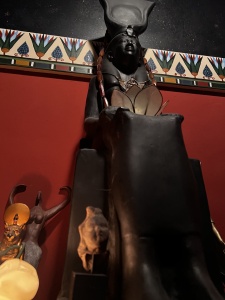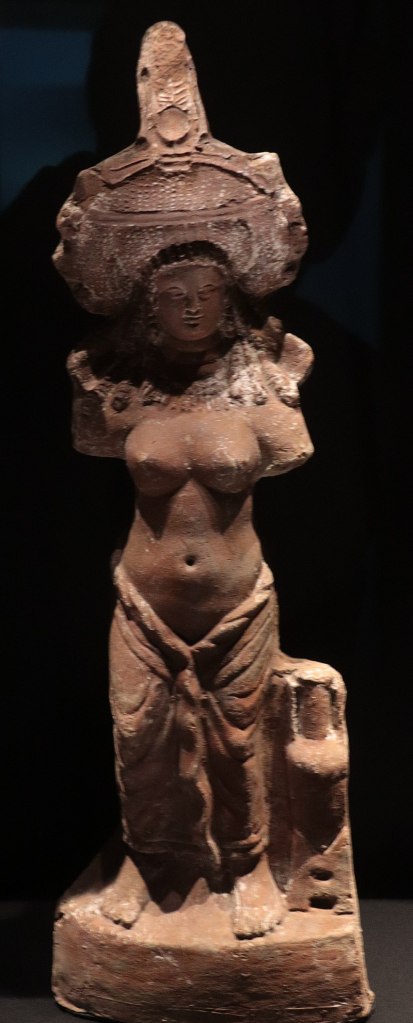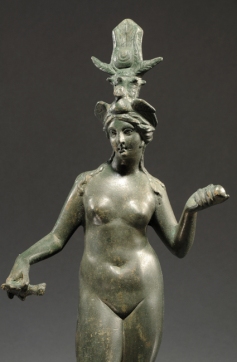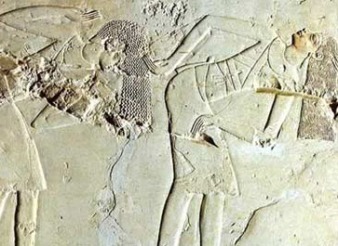Several posts ago, I mentioned a particular type of graffiti found at Isis temples in Egypt and in other locations throughout the Mediterranean. These are the images of a foot or feet or footprints that were sometimes scratched on or near Her temple or shrine. Similar feet have also been found carved on separate stone slabs and placed within temples. In Egypt, we find these feet images associated with Isis in Abydos and Philae. Outside of Egypt, we find them in Delos, Chaeronea, Thessaloniki, Maroneia, Rome, and more.
If you’ve ever traveled to a sacred place, you may have been tempted to leave behind an offering or token of some kind to mark your journey. On my own recent pilgrimage to Isis’ temple at Philae in Egypt, it seems I left such a token—if inadvertently. On the boat ride to Her temple island, I was wearing two pieces of jewelry: a knot of Isis and a tiny sistrum. I paid no attention to them at all while we explored Her sacred temple. But on the boat ride back, I had only the tiny sistrum. The knot of Isis must have fallen off sometime during our visit.
Yet the loss made me happy. Why? Because I had had a premonition that something would happen while I was there. I believe that what happened was that Isis accepted the offering that I had unconsciously brought Her. I have since wondered if the Goddess re-gifted it to some other visiting priestess and absolutely made her day, week, and month. I hope so; that’s my fantasy, anyway.
Of course, I would never have etched my footprints or left graffiti on Her temple as some ancient visitors before me had done. I mean, what were they thinking!?! And, in fact, that’s exactly what I’d like to explore today: what were they thinking, and what are those footprints about anyway?
In a general sense, footprints are tangible proof that someone was here; right here—and substantial enough to leave a print. Remember the Ice Age footprints discovered in New Mexico several years ago? They are of a woman and child and they’re the longest continual track of fossilized footprints found to date; they continue for almost a mile. Because of the pace of the footprints and the changing depth of the imprints, researchers can tell something about what may have been happening to those people at that time. Or remember how affecting seeing Buzz Aldrin’s human footprint in the dust of the moon was? Or perhaps you’ve been intrigued by the celebrity footprints (and handprints) outside Grauman’s Chinese Theatre in Hollywood? Like a fingerprint, a footprint uniquely represents the one who made it.
Footprints can often have a spiritual significance, too. Across the world, people have always pointed out what they say are footprints of Deities, heroes, and supernatural beings. Some are natural footprint-shaped indentations in rock, while others are human-created, like the giant God-footprints in Syria’s ‘Ain Dara temple. Such physical evidence is meant to clearly demonstrate the Deity’s Presence. These God-sized footprints may be meant to commemorate a human being’s experience of Divine epiphany. Or their permanence, especially in a temple, may be meant to say, “the Deity is always here.” However we interpret them, there is magic in them.

Isis is, of course, one of the Deities Who left such evidence of Her Divine Presence in Her temples. We have a limestone slab from Alexandria, Egypt that shows a single, large footprint that has been conveniently labeled for us in Greek: Isidos Podas, “Foot of Isis.” Separate stone slabs like this, incised with a Divine foot or feet, seem to have been an Egyptian thing and is attested for Egypt from at least the 5th century BCE. Similar carved slabs are also found throughout the Mediterranean, and often in temples of “The Egyptian Deities.” During the Hellenistic and Roman periods, “the Egyptian Deities” meant specifically Isis, Serapis, Harpokrates, and Anubis. Sometimes, other symbols related to the Deity are carved along with the foot or feet, or the dedication informs us that it was given to fulfill a vow or “by order of” the Deity.
We sometimes also find votive footprints carved in stone that would then be set into the floor of the temple. In the Isis temple in Baelo Claudia, Spain, the footprints are offset, as if in movement, and seem to lead toward the altar. (I love this.) In this case, the footprints have been interpreted as the path walked by Isis’ priests as they served Her or as the steps of the Goddess Herself as She attends the ceremonies at Her temple. Another small Isis sanctuary near Seville shows similar treatment with the footprints approaching the sanctuary entrance.
From the sacred island of Delos in Greece, we have a pair of footprints, labeled as “footsteps” and dedicated to Isis Dikaiosyne, “Isis of Justice,” by “order of the Goddess.” Another set of Goddess-sized footprints from Delos were dedicated to Isis and Anubis by at least three women. From Chaeronea, we have sandalled feet dedicated “following the command of Isis.” We have similar dedicated footprints from the acropolis in Athens and from Thessalonike.
While oversized footprints usually represent Deities, smaller, human-sized ones represent Their human worshipers. The footprint demonstrates the worshiper’s presence before the Deity at Their temple. Some of the earliest examples come from Egypt. We find them not only in temple complexes, but also in hilltop locations, perhaps putting the human closer to the Divine in this elevated position. In Egypt, there are hundreds of examples and they date from as far back as the Old Kingdom. Some were made by visitors to the temples, but many were made in areas—such as the roof—that were inaccessible to anyone but the clergy. Thus it seems to have been a privilege of the priests to be able to put themselves in continual proximity to the Deity of the temple. In fact, the four instances of footprint graffiti found at Isis’ Philae temple come from a single family that served there as priests of Isis. (Researchers also note that some of the footprints from Egypt are found in secular contexts, often made by soldiers, and simply say, “I was here.” Because. Humans.)
Sometimes we find a larger footprint beside a smaller one, perhaps to represent the Deity and Their worshiper. An example of a set of footprints like these comes from the Temple of Isis Locheia in Dion, Greece. They may be meant to show that the devotee is walking beside her Goddess. Since Isis Locheia is a protector of women in childbirth and of children, we can surmise that the footprints represent a pregnant woman asking protection from her Goddess.
We also find a number of these footprint dedications given by now-free, formerly enslaved people. Both Isis and Serapis were known to help manumit slaves through a fictitious “sale” to the Goddess and God.
Later, during the Roman Imperial period, a new kind of “foot” comes into vogue. It is a gigantic 3D sculpture of a Divine foot. A famous example is the Piè di Marmo (“Marble Foot”) that now resides on Via del Piè di Marmo in Rome and which is believed to be a large foot of Isis (or possibly Serapis) from the temple of Isis Campense or the Serapium. These feet are free-standing and not part of a large, lost statue. In other words, the whole Deity is represented by the foot. Scholars believe that this trend, too, first developed in Egypt and was exported to other sanctuaries in the Mediterranean.
The concept of representing ourselves or our Deities by footprints—by the traces left behind by our presence or Their Presence—is found worldwide. People everywhere do it and have done so for thousands of years. The many “footprints of Buddha” are just one example from outside the Mediterranean region. They are, I believe, similar in meaning to the prehistoric handprints found in caves from Indonesia to France.
In Egypt, we have Old Kingdom evidence of the idea that “my footprint means I was here” in both secular and sacred contexts. By the New Kingdom, oversized Divine footprints begin to appear. But instead of being etched into temple walls or roofs, they are often carved on separate slabs of stone and dedicated in temples. We begin to see this trend outside of Egypt, too, especially in temples of Isis and Serapis, but also in temples of other Deities in sanctuaries throughout the Mediterranean. Remember the ones at Hekate’s temple in Karia?
For the Isis shrine in my backyard, we purchased two slabs of rock that we intend to have sandblasted with a pair of votive feet, right foot on one, left on the other. This is a project yet to be done, but after looking into this interesting little chapter in the worship of Isis, I’m gonna have to get on that. She needs some footsteps of Her votary—me—leading into Her temple.




































